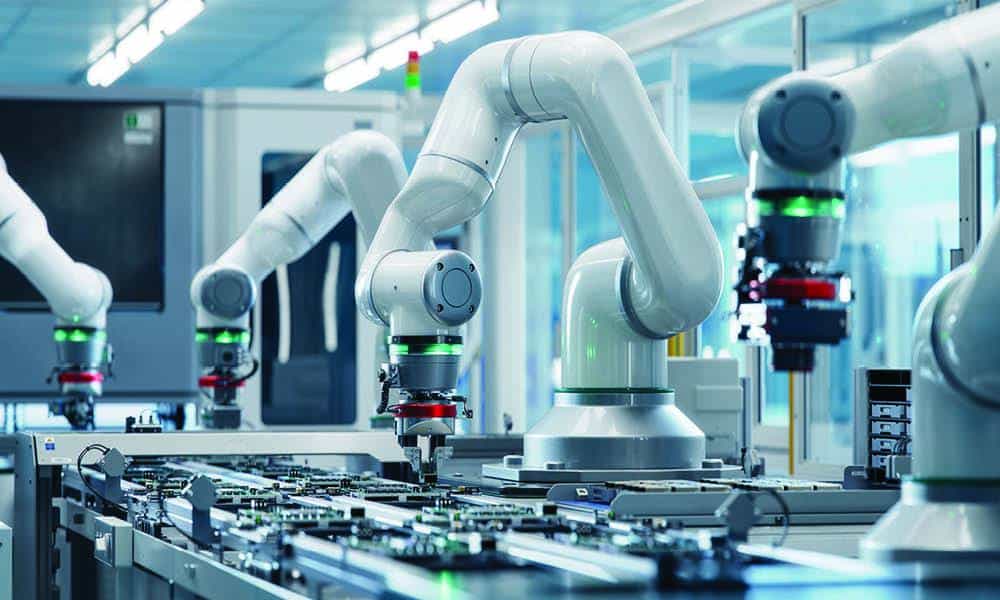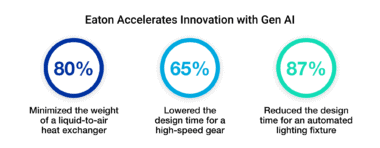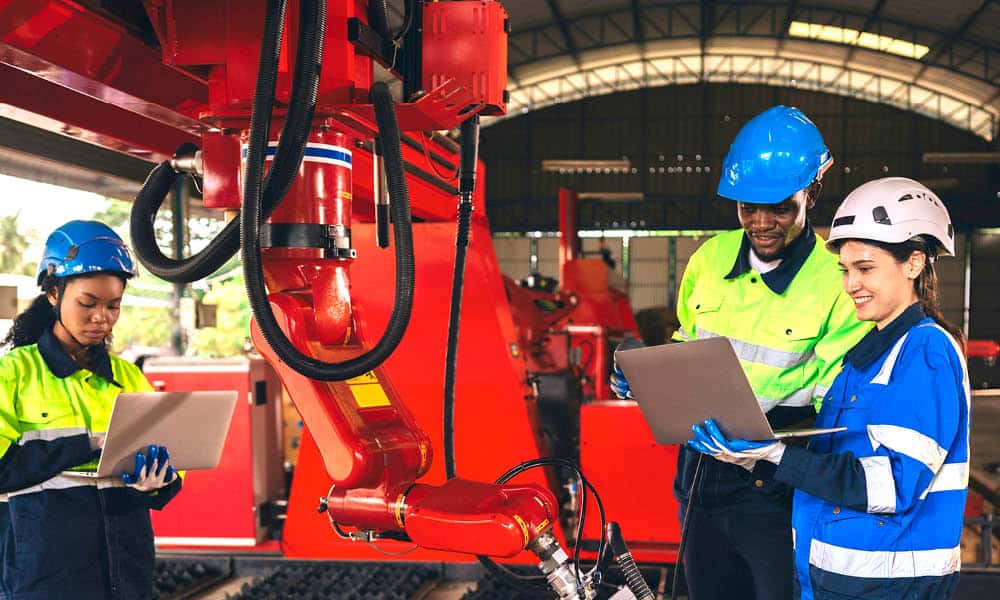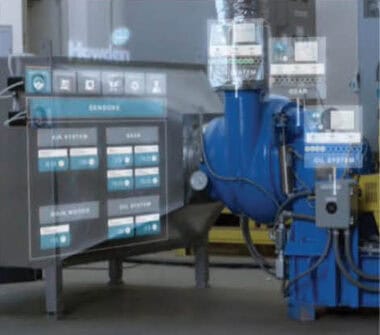Preparing the Supply Chain Workforce for an AI Revolution

To capitalize on AI, companies need to build a strong data foundation and upskill their workforce with AI skills.

TAKEAWAYS:
● Manufacturers cannot afford a wait-and-see approach–they need to explore where AI adoption will provide the most tangible and immediate benefits.
● AI can increase the efficiency of administrative tasks, predict demand patterns, and improve inventory planning.
● Companies will need to upskill their existing teams to succeed in a data-driven environment and maximize new AI-enabled capabilities.
Artificial intelligence (AI) has the potential to transform every aspect of a manufacturer’s business—but some of its greatest impact will be on the supply chain.
Supply chain professionals will be able to enhance their work with the insights that AI provides, allowing them to bring together data from around the business in real time to make data-driven decisions and uncover opportunities to mitigate risk and improve resilience. They can also use AI to increase the efficiency of administrative tasks, predict demand patterns, improve inventory planning, and much more. Many supply chain professionals will soon interact with AI for the first time in their careers as manufacturers seek to increase their AI and machine learning (ML) investments. In fact, BDO’s 2024 Manufacturing CFO Outlook Survey found that 47 percent of chief financial officers (CFOs) are increasing investment in AI and ML this year.
While AI is promising, manufacturers need to build the foundation for adoption; otherwise, their investments will not realize expected return on investment (ROI). How can manufacturers prepare their supply chain management teams for AI adoption?
In this article, we explore steps manufacturing leaders should take to enable successful AI adoption in the supply chain function:
- Build a strong data foundation
- Enable cross-functional collaboration
- Foster AI-related skills in the supply chain workforce
- Create a culture of curiosity around AI usage
Build a Strong Foundation
The first step in any organization’s AI journey is to build a strong data foundation. This involves consolidating disparate data sources, ensuring all data are stored in an accessible location with appropriate reference fields enabling analysis across datasets, and implementing strong data governance standards and processes. Digitally mature manufacturers may already have this data infrastructure in place; however, many manufacturers’ existing data management practices are insufficient to support many of the most promising AI use cases.
To build this foundation, manufacturers need AI-savvy data scientists to help them interrogate and analyze data to extract useful insights. Manufacturers can either hire data scientists directly or work closely with a third-party provider experienced in helping companies set up their data infrastructure.
“Many supply chain professionals will soon interact with AI for the first time in their careers as manufacturers seek to increase their AI and machine learning (ML) investments.”
Once an organization has data scientists onboard, it should collaborate with operations, supply chain, quality, and other leaders to identify the business problems it is trying to solve and the relevant internal and external data that will power its AI tools. Once these are identified, the organization can begin designing the company’s AI-enabled strategy.
Enhancing Cross-functional Collaboration
To deliver the most value, AI requires access to data from across the organization. Enabling this kind of data sharing requires the integration of many disparate systems—including warehouse management systems (WMS), customer relationship management systems (CRM), supplier relationship management systems (SRM), and enterprise resource planning systems (ERP).
The supply function is an ideal area to roll out new data-sharing processes, as supply teams already naturally interact with groups across organizations. Supply leaders can be critical partners to data scientists and other individuals leading AI adoption and setting up new tools and processes. Strong data governance is also critical to ensure that AI tools provide accurate outputs based on high-quality, reliable data sets.
Effective data sharing across systems can provide supply chain professionals with real-time, organization-wide visibility. Powered by AI, supply chain professionals can have quick access to aggregated insights that enhance their decision-making and free them up from having to perform manual analysis. For example, a procurement professional at an appliance manufacturer may receive an automated alert from an AI-powered tool that there has been an influx of negative customer feedback pouring into its CRM system due to unreliable electric motors in some washing machines. Since the CRM system shares data with the company’s SRM system, the procurement professional can identify the relevant supplier and reach out to discuss how to alleviate the issues. The company could also use this information to inform benchmarks for supplier performance.
Fostering New Skills
While many supply chain organizations will need to hire professionals with knowledge of strong data governance principles and an understanding of how large language models and other AI solutions work, the larger challenge will be upskilling their existing teams to succeed in a data-driven environment and optimally leverage the company’s new AI-enabled capabilities.
In a world where machines can automate tasks, perform rapid calculations, and analyze vast data sets to uncover deep connections and patterns, leading supply chain organizations are prioritizing analytical thinking and digital dexterity—that is, the ability of employees to adopt and adapt to using emerging technologies to deliver improved business results—as part of their core curriculum to upskill supply chain teams. Training supply chain professionals to use generative AI tools is also essential. For example, if a manufacturer is deploying generative AI tools, training on prompt engineering—that is, how to design effective queries to extract the necessary data from AI tools in a useful format—will be vital.
“Starting with a small pilot project focused on achieving tangible, near-term ROI can help get team members on board and establish internal AI champions.”
Application-based instruction that leverages a controlled AI environment that is disconnected from the company’s production systems will be critical to building these skills. The test environment can also teach employees about their company’s acceptable use policies for AI and provide a safe place for professionals to learn from mistakes.
Many companies are also investing in third-party developed prompt libraries or guides for sample queries to run in specific scenarios to support increased user adoption. For example, an advanced inventory planning tool might recommend questions like “identify which suppliers have had lead times that were more than five days past system projections over the past three months.”
Creating a Curious Culture
Successful AI implementation requires empowering individuals to use AI and ML tools in their everyday work. To encourage adoption, manufacturers need to foster a culture of curiosity by training and inspiring their teams to explore the possibilities that AI tools can provide. This culture can also help manufacturers overcome common roadblocks to adoption.
For example, some supply chain professionals may worry that AI will replace them or will complicate their jobs. Explaining how AI can augment (versus replace) human expertise and judgment is essential to overcoming these hurdles. Beyond mitigating replacement concerns, manufacturers can demonstrate the value that achieving mastery over AI tools and skills can have for their employees’ professional development.
Starting with a small pilot project focused on achieving tangible, near-term ROI can help get team members on board and establish internal AI champions. For instance, a manufacturer that has access to an internal generative AI tool could work closely with procurement teams to show how it could support researching new vendors or generating information that may be helpful in a negotiation.
The Future Won’t Wait
AI is no longer on the horizon—it’s here, and leading manufacturers are moving quickly to explore how AI-driven solutions can enhance productivity, quality, and safety while making companies more resilient and cost-effective.
Manufacturers who want to remain competitive can’t adopt a wait-and-see approach. Instead, they need to start preparing their organizations for AI by establishing their data infrastructure, equipping their teams with the necessary skills, while also exploring where AI adoption will provide the most tangible and immediate benefits. Those initial wins can then be scaled into broader solutions that create a long-term competitive advantage. M
About the authors:

Jim Blackwell is market leader at BDO Digital.

Maurice Liddell is manufacturing market leader at BDO Digital.

R. J. Romano is supply chain managing director at BDO USA.
From Months to Minutes: How GenAI and AI Transform Product Design and Sourcing

Manufacturers have a treasure trove of data that GenAI can use to enhance performance, agility, and growth.

TAKEAWAYS:
● By combining actual historical product data and simulated insights, manufacturers can unlock new levels of innovation and competitiveness.
● More manufacturers are harnessing GenAI—Eaton, for example, is using the technology to cut product design time by nearly 90 percent.
● Manufacturers that combine robust data sets with clear GenAI use cases are well-positioned to harness the transformative power of GenAI.
Manufacturers are already seeing glimpses of how artificial intelligence (AI) is reshaping the industry. Applying AI to R&D/product design can have a force multiplier effect across the entire product development lifecycle. Companies can use generative AI (gen AI) to develop new products at lightning speed that are already optimized for cost, carbon, performance, and even factory location. To illustrate the focus in this area, Bain & Company1 reports that 75 percent of manufacturers surveyed list AI and related technologies as their top engineering and R&D priority.
But missteps today could leave companies adrift amid the AI sea change and unable to navigate new market realities. Proactive manufacturers are addressing how gen AI capabilities differ from traditional AI, are defining specific gen AI use cases for their needs, and are taking steps to generate value from this new technology.
What is Gen AI?
Generative AI represents a new frontier in AI (ChatGPT may be the most well-known example). Traditional AI, also known as deterministic AI, applies pre-programmed rules and algorithms to make decisions. Traditional AI systems solve well-defined problems—for example, determining the most effective manufacturing process based on the properties of a specific part—and perform repetitive tasks.
Instead of using predetermined rules, gen AI identifies data patterns to create new, unique content. This requires accurate data, machine learning (ML) for powerful analysis, and large multimodal models (LMMs) to process and generate information across multiple formats, including text, images, and video.
Data Quality: The Launchpad for AI Innovation

Financial services and other industries are awash in data because different industry sub-segments—such as consumer banking and asset management—can use similar data sets to create AI models for automated customer service and other applications. But that scale doesn’t apply to manufacturing because many sectors have different operating models (think high-volume consumer electronics manufacturing vs. low-volume products for aerospace or other highly regulated industries).
To compensate, manufacturers are combining actual historical product data and simulated insights to provide the data volume and quality required to make informed decisions.
How to Capitalize on Actual Historical Information and Simulated Design Data
A manufacturer’s actual historical data can include design files of its popular products, a list of its highest-margin products, product costs, production volumes, and preferred supplier information. It can also feature detailed performance data regarding company-owned factories and/or production lines.
However, analyzing a manufacturer’s actual historical data doesn’t typically help to identify areas for cost or time savings. For example, how do manufacturers know if they’re overpaying for a component if they only have quote and payment information?
To gain these types of insights, manufacturers rely on simulation and modeling to identify opportunities for improvement across the organization—including design for manufacturing (DFM), cost modeling, sustainability insights, and structural performance (FEA analysis). These simulation applications provide additional analysis and guidance to optimize an array of variables.
“Missteps today could leave companies adrift amid the AI sea change and unable to navigate new market realities.”
Integration across applications and platforms is central to harnessing all manufacturing information effectively. With complete control over product data, manufacturers can instantly adjust shop floor labor rates for a plant in Taiwan or update raw material cost data to reflect inflationary pressures.
Manufacturers who understand why there are discrepancies between actual historical data and insights from simulation applications can use this knowledge to build precise AI models based on the most accurate information and establish parameters from multiple types of data.
Eaton Spotlights the Power of Gen AI
Eaton is a $23 billion intelligent power management solutions provider for industrial and manufacturing industries. Customers regularly require customized Eaton components/products for their new product development initiatives, which can range from passenger car valve stems to lighting fixtures.
Due to technical complexity, it can take Eaton months to complete a manual product design. For example, a lighting fixture design can require input from thermal, electrical, mechanical, optical, and manufacturing engineering.

“Eaton’s vision is to take our traditional design processes from months to minutes,” said Uyiosa Abusomwan, senior global technology manager of Digital Design and Engineering at Eaton.
Eaton’s gen AI capability is built on a robust set of actual historical product design data and insights from the company’s simulation software portfolio—including aPriori for cost modeling, DFM, and sourcing. Eaton combines this information to create detailed model-based design specifications and properties to support its gen AI development.
With gen AI, Eaton runs thousands of design iterations in minutes (or less) and proposes the top five designs. Once the designs are fed through a high-fidelity simulation, Eaton’s digital design and engineering team conducts a detailed review. This workflow empowers the Eaton engineering team to review AI outputs for product validation and quality control, and to streamline decision-making.
Result: Eaton Cuts New Product Design from Months to Minutes
Eaton’s impressive results from its high-fidelity gen AI initiative include the following:
- Minimizing the weight of a liquid-to-air heat exchanger by 80 percent
- Lowering the design time for a high-speed gear by 65 percent
- Reducing the design time for an automated lighting fixture by 87 percent
Eaton’s gen AI capabilities support the company’s goal to scale new product development and accelerate time-to-market to address customer needs. The technology could also support the company’s goal to become carbon neutral by 2030.
Take the Next Step In Your Gen AI Strategy
Despite some early forays into gen AI, manufacturers are still primarily laying the groundwork in this area. The MLC’s “Future of Industrial AI in Manufacturing” survey reports that 28 percent of respondents have gen AI projects that “passed the pilot stage.” What’s revealing is that more than half of those surveyed aren’t incorporating gen AI into their digital transformation strategies, and nearly two-thirds aren’t measuring the impact of their AI investments.
Gen AI technologies continue to evolve rapidly in this dynamic field. Given the pace of innovation, it’s hard to predict what AI algorithms will be capable of during the next few years. However, the need for accurate, robust data are a constant pillar for AI and other business-critical operations.
Today, companies have a wealth of information to harness for short-term gains and long-term success: traditional AI engines that power product design, sourcing, and digital factory simulation—along with their actual product data. Gen AI is uniquely positioned to transform the entire product development lifecycle. Manufacturers that act quickly and strategically are well-positioned to gain new levels of performance, growth, and agility. M
About the author:

Philippe Adam is the chief marketing officer at aPriori.
References:
1. Bain & Company. “Bain’s Global Machinery & Equipment Report 2024.” 2024.
2. Manufacturing Leadership Council. The Future of Industrial AI in Manufacturing. 2023.
Empower Your Workforce with Generative AI

Generative AI is increasing the potential for data to fundamentally change the way manufacturers operate throughout the manufacturing value chain — and bring significant value for the workforce.

TAKEAWAYS:
● Data currently is seriously underused at the operational level, leading to wasted potential for performance improvement.
● GenAI can empower worker efficiency and effectiveness — if they use it correctly. The key is focusing on how AI can augment workers’ expertise and make them more efficient and productive.
● Most manufacturers don’t collect and retain the data needed to benefit from AI. This is a good place to start.
In the Manufacturing Leadership Council’s study, Manufacturers Go All-In on AI (October 2023), nearly half of executives cited AI/machine learning (ML) as the technology they expect to have the most future impact on manufacturing operations — more than any other mentioned. Almost half — 47% — expect it to be a game changer by 2030. In Rockwell Automation’s State of Smart Manufacturing Report, generative AI was the No. 1 area for technology investment in the next 12 months, and 83% of those polled anticipate using it in 2024.
West Monroe’s survey of mid-sized manufacturers, The State of Manufacturing, shows companies are realizing the benefits from AI and ML, and increasingly infusing data into their operations. But one finding stood out: While 84% of companies surveyed use data extensively for decision-making at the executive level, that does not carry to other levels. Only 38% of middle management uses data extensively, and 47% of operational staff rarely use data.
Think about the wasted performance potential that statistic implies. Leveraging data in real time on the operations floor can help employees think more strategically, make informed decisions that reduce costs and improve margins, and drive businesses forward. That’s where AI comes in. It harnesses exponential volumes of data currently going unused to improve manufacturing operations — putting insight in the hands workers that makes them more effective and efficient.
But first, workers need to become comfortable with AI. Real or not, perceptions abound that AI will replace human work and jobs. In The Future of Industrial AI in Manufacturing, executives were mixed on this point. Nearly half (45%) said they don’t expect an impact on the workforce. But a sizeable minority, 21%, do see it decreasing the size of the workforce.
To unlock value for the workforce, manufacturers should be focusing on AI as a way to transfer knowledge “within the four walls” and augment workers’ expertise—empowering them perform day-to-day responsibilities better and more efficiently. Following are some principles for doing so.
Ensure Employees Are Using AI Right
According to Microsoft, 75% of knowledge workers are already using GenAI at work. But in our opinion, many are using it wrong. They are defining their own tools and approaches, without sufficient monitoring or governance. It’s up to leadership to convince employees to use it the way the company wants. Understand that guiding appropriate GenAI adoption requires:
- Both a top-down and bottom-up strategy
- More of a cultural movement and less of a mandate
- Trust and mentorship
- Success metrics defined on both at the company and individual level
Educate Everyone — Continuously
Because AI is a rapidly evolving discipline, education isn’t a one-and-done project. It requires continuous focus and effort. And it involves everyone—from senior executives to the shop floor. Seek to learn everything you can about the fundamentals of large language models (LLMs), the options, and the skills required. Don’t just read about it. Engage with manufacturing peers or other organizations to share experiences and points of view.
Given the buzz around GenAI, it is particularly important to understand the differences between this form of AI and the broader concept of AI/ML. In a mature state, both AI/ML and GenAI may play roles in optimizing manufacturing operations. A good example is machine maintenance. By putting sensors on equipment, you can use analytics to predict when the machine will need maintenance. That is AI/ML. When the technician is performing maintenance has questions, GenAI can provide answers rapidly, in an easily understandable format.
Pursue the Right Use Cases
We see many organizations trying to explore as many use cases as possible rather than focusing on a handful of the most promising ones. Casting a wide net is a good starting point, but we guide clients to use a value-identification exercise to build a prioritized funnel of potential use cases for further exploration. Make employee efficiency, productivity, and/or effectiveness part of the value formula.
Every function will have its own high-value use cases, but in manufacturing operations, we see three that have significant potential for empowering the workforce:
Reduce the time to output. PLC programming is a good example of this. Say it currently takes one day to code a PLC. With support from GenAI, which augments knowledge and quickly iterates ideas for the desired output, a programmer could produce code in 60% of the time — a 40% efficiency gain. Here, AI isn’t replacing people, but it is helping them to work faster.
Manage uncertainty better. Unanticipated scenarios often disrupt monthly, quarterly, or yearly plans. Machines break down, people don’t show up for work, or defects materialize. In the rush to get back on track, there usually isn’t time to gather and analyze all the potentially relevant information needed to make the best possible decision. AI makes it possible for users to access and analyze data from more sources, internal and external, to reach conclusions that otherwise may not have been possible — injecting a greater degree of reliability into operations. For example, a large Japanese steel manufacturer implemented AI for predictive maintenance and to optimize blast furnace operations, achieving significant cost savings, operational efficiency, and reduced unexpected downtime.
“Given the buzz around GenAI, it is particularly important to understand the differences between this form of AI and the broader concept of AI/ML.”
Knowledge retention and transfer. In West Monroe’s manufacturing poll, 95% of respondents said they worry about the impact of an aging workforce — a key concern, of course, being loss of institutional knowledge. Here again, AI, and particularly GenAI, may be useful for capturing and sharing that knowledge before it walks out the door. For example, create a simple standard root-cause analysis form and begin using it to capture data from operators every time there is an issue. You can then train an LLM to analyze that database of information, along with SOPs, best practices, and troubleshooting guides. Workers grappling with an issue can query the LLM to access relevant policies, instructions, or suggestions.
Integrate AI with Tools Familiar to Workers
One of the beneficial features of AI is the ability to integrate with other systems (relatively) easily. As a result, users can benefit from its capabilities without having to learn an entirely new tool. A worker can query a familiar interface — for example, a commercially available manufacturing intelligence/analytics platform that uses the data from the MES system — to retrain pretrained models to get customized answers for problems that are very specific and contextual to the manufacturer, or even to a specific facility.
In addition, the insights can be made available to worker in a tool familiar to the worker, thus reducing adoption challenges. Industrial co-pilots that can collected MES and other manufacturing data and then leverage the power of GenAI to provide insights in an easy-to -understand form. An example interaction would be where a plant manager can query the Co-pilot in plain language to “forecast the energy consumption of the blast furnace for the next week” and receive an easy-to-understand line chart forecast.
Shore up Your Foundation for Using AI
The idea of using AI to predict machine failure and maintenance requirements is enticing, but the reality is that most companies don’t have the essentials — including job plans or accurate data — to address common failures. Many do not routinely review maintenance procedures for specific equipment. Some don’t have documented procedures at all. The same applies to standard operating procedures. They may exist, but they may be out of date.
One of the most important foundational elements for AI is good data. Many manufacturers don’t collect or retain the data needed to benefit from AI, so that is a starting point. Some collect data, but haven’t “cleaned” it (i.e., detecting and correcting corrupt, inaccurate, or duplicate records from a database) so that analytics tools can produce useful insight. Data hygiene is mundane and laborious — but ignoring it and expecting AI to be able to overcome issues will ultimately lead to suboptimal impact. Think garbage in, garbage out.
If you have high hopes for leveraging AI to elevate performance, start by fixing these core building blocks. An easy way to think about this is cleaning up the dirty laundry that’s been building over the years. Every manufacturer has a pile of it. And every little bit of work to address it will ease the ability to employ and benefit from AI.
Don’t Underestimate the Change Management
For AI to truly become a tool that augments work and improves efficiency, the workforce must become comfortable with and understand it — including what is changing, why, and what’s in it for them. Leadership must actively dispel the myth that machines are here to replace workers. This is also a great opportunity to instill a deeper understanding of work, how individuals’ roles impact performance and how the introduction of GenAI or AI will change work. The change management plan should reflect this.
“Look for ways to begin infusing GenAI into the daily responsibilities of those doing knowledge, leadership, or decision-making work by explicitly making it part of their roles.”
Change management will require a shift in focus from training to learning, as well as new methods of delivering insight that emphasize coaching and mentoring rather than classroom education. In the MLC’s study, linked above, 65% of companies have yet to allocate specific budgets for AI training, highlighting the potential challenges for future workforce readiness.
One way of acclimating workers to change is a “quiet pilot.” For example, you can introduce a small-scale GenAI-powered “how-to” guide within an existing application. This guide can provide prompts and assistance based on the user’s role, helping them discover and use the AI tool independently. This approach introduces people to the concept of AI without making it seem like a big change. It also allows for quick learning and adjustments that can be applied to future investments.
Build GenAI into Roles
Finally, look for ways to begin infusing GenAI into the daily responsibilities of those doing knowledge, leadership, or decision-making work by explicitly making it part of their roles. While this is a recommendation for “right now” it is also encouraged in how manufacturers frame and design jobs going forward. Weaving GenAI activities into roles and responsibilities challenges managers and leaders to re-think the way work can be done. And adding “Experience leveraging GenAI in daily activities” into the knowledge, skill, and experience sections of position descriptions helps to groom the candidate pool, while exploring GenAI skills and experiences in interviewing prospective employees enables manufacture to truly begin building the workforce of the future. This combination reinforces that in most cases GenAI isn’t “a job” but rather a way of working more efficiently in many different jobs.
Take Action—and Start Adding up the Value
The Rockwell Automation State of Smart Manufacturing Report confirms what many manufacturers know: they are using a relatively low percentage (44%) of data effectively. AI can help you begin boosting this right away — and spread the impact from the executive suite down to your operational workforce. The key is focusing on how AI can augment workers’ expertise and make them more efficient and productive. This takes coordinated effort around people, processes, and technology, but the steps above will point your organization in the right direction. M
About the authors:

Sujit Acharya is a Managing Director with West Monroe’s Technology Practice.

Randal Kenworthy is Senior Partner, Consumer and Industrial Products, with West Monroe.

Kris Slozak is Director, Consumer & Industrial Products, with West Monroe.

Glenn Pfenninger is a Director, Human Capital Management, with West Monroe.
Manufacturing in 2030: The Opportunity and Challenge of Manufacturing Data

As manufacturers move toward building smarter factories with connected machines, the data those systems produce can offer a host of benefits: improved efficiency, better productivity, informed decision-making, value creation and, ultimately, competitiveness. Yet becoming a data-driven business comes with its share of challenges. In this year’s Manufacturing in 2030 Survey, Data Mastery: A Key to Industrial Competitiveness, the NAM’s Manufacturing Leadership Council sheds light on the successes and opportunities for how manufacturers are transforming their operations with data.
Security and privacy concerns: As factories become more connected, cybersecurity becomes a greater imperative. For this reason, survey respondents validated that both data security and data privacy are essential.
- More than 90% of respondents have a formal or partial policy on data security and data privacy.
- About two-thirds of manufacturers have a formal or partial policy on data quality.
- More than 60% have a corporate-wide plan, strategy or guidelines for data management, but only 15% follow the plan in its entirety.
How data is used: As manufacturers advance along their M4.0 journey, data is becoming their lifeblood, driving insights and decision-making. Yet the survey revealed a gap between available data sources and their utilization, a notable area for improvement as the industry looks toward the future.
- Spreadsheets are still king: 70% of manufacturers enter data to them manually, and 68% still use them to analyze data.
- 44% of manufacturing leaders say the amount of data they collect is double what it was two years ago, and they anticipate it will triple by 2030.
- While nearly 60% of manufacturers use data to understand and optimize projects, there is a shift toward using data to make predictions about operational performance, including machine performance, in the next decade.
Business impact: Most manufacturers leverage data to find ways to save money or promote business growth. However, less than half have a good understanding of the dollar value of their data.
- Only about 25% of manufacturers have high confidence that the right data is being collected.
- Most manufactures have only moderate confidence in their analytic capabilities.
- Top challenges include data that comes from different systems or in different formats (53%), data that is not easy to access (28%) and lack of skills to analyze data effectively (28%).
- However, despite those challenges, 95% of manufacturers say data makes for faster and/or higher-quality decision-making.
The bottom line: An overwhelming majority of manufacturers (86%) believe that the effective use of manufacturing data will be “essential” to their competitiveness. But to realize data’s potential, manufacturers must figure out how to organize and analyze their data effectively, ensure that their data is trustworthy and align their business strategy closely with their data strategy.
Explore the survey: Get a deeper look at the current state of data mastery in manufacturing. Click here to download your copy.
Announcing the Winners of the 2024 Manufacturing Leadership Awards

The names are in! The Manufacturing Leadership Council—the NAM’s digital transformation division—is pleased to announce the winners of the 2024 Manufacturing Leadership Awards.
Now in its 20th year, the awards competition recognizes outstanding manufacturing companies and their leaders for groundbreaking use of advanced manufacturing technology.
“The class of 2024 should indeed be proud of their achievements in advancing the digital model of manufacturing,” said MLC Founder, Vice President and Executive Director David R. Brousell. “The awards reflect the truly incredible amount of innovation taking place in all sectors of the industry.”
Manufacturing Leader of the Year: Cooley Group President and CEO Daniel Dwight is the 2024 Manufacturing Leader of the Year.
- Dwight, who also serves on the MLC’s Board of Governors and is a member of the Executive Committee of the NAM Board of Directors, has overseen a significant turnaround in Cooley’s business performance through digital transformation, with a commitment to investing in smart factory technologies and developing a digital-ready workforce and business culture.
- In addition, the MLC named Cooley Group the 2024 Small/Medium Enterprise Manufacturer of the Year.
Large Enterprise Manufacturer of the Year: Intertape Polymer Group is the 2024 Large Enterprise Manufacturer of the Year.
- The award recognizes IPG’s achievements in digital transformation, including technology integration and workforce training.
- The company has also made noteworthy strides in sustainability through reductions in both energy usage and waste.
More honors: The MLC also announced winners in 11 project and individual categories, as well as the winners of the Manufacturing in 2030 Awards. The latter are given to projects with particularly forward-thinking innovations.
- The MLC honored all finalists and winners at the Manufacturing Leadership Awards Gala last night in Marco Island, Florida. A complete list of finalists and winners is available here.
Nominations for the 2025 season of the Manufacturing Leadership Awards will open on Sept. 16, 2024. More information is available here.
Intertape Polymer Group, Cooley Named Top Winners in 2024 Manufacturing Leadership Awards
Daniel Dwight named Manufacturing Leader of the Year in awards program's 20th season
Marco Island, Fla. – The National Association of Manufacturers’ Manufacturing Leadership Council has named Daniel Dwight, President and CEO of Cooley Group, as the 2024 Manufacturing Leader of the Year. Dwight has overseen a significant turnaround in Cooley’s business performance through digital transformation with a commitment to investing in smart factory technologies and developing a digital-ready workforce and business culture. Dwight also serves on the MLC’s Board of Governors and is a member of the NAM Board of Directors Executive Committee. Additionally, Cooley Group was named the 2024 Small-Medium Enterprise Manufacturer of the Year.
Intertape Polymer Group was named the Large Enterprise Manufacturer of the Year in recognition of its achievements in digital transformation, including technology integration and workforce training. The company was also recognized for its noteworthy achievements in sustainability through both reductions in energy usage and waste.
“The class of 2024 should indeed be proud of their achievements in advancing the digital model of manufacturing,” said David R. Brousell, Founder, Vice President and Executive Director of the MLC. “The awards reflect the truly incredible amount of innovation taking place in all sectors of the industry.”
The 20th annual award ceremony took place at the conclusion of Rethink: Accelerating Digital Transformation in Manufacturing, the MLC’s signature event that focuses on insights and strategies for how manufacturers can further their operational digital transformation. The event took place at the JW Marrott Marco Island Beach Resort in Florida June 2-5.
“Manufacturers continually find new and inventive ways to not just bring new technology into their factories, but also how to leverage it for highly effective problem solving and even developing new processes and products that can allow for entry into new markets and new revenue streams,” said Penelope Brown, Senior Content Director and head of the MLC Awards program.
Manufacturing Leadership Award finalists and winners are determined by a distinguished panel of judges with significant industry expertise and experience. In addition to Cooley and IPG, the judges also conferred honors on the following category winners:
AI and Machine Learning
Celanese
Collaborative Ecosystems
Anheuser-Busch InBev
Digital Network Connectivity
Molex
Digital Supply Chains
The Wonderful Company
Engineering and Production Technology
Van Wijnen Smart Structures
Enterprise Integration and Technology (tie)
Dow
General Motors
Operational Excellence
Owens Corning
Sustainability and the Circular Economy
Intertape Polymer Group
Transformational Business Cultures
Humtown Products
Digital Transformation Leadership
Julian Tan, IBM
Next-Generation Leadership (tie)
Angela Accurso, MxD
Marlon Gonzalez, IBM
Manufacturing in 2030 Awards
Anheuser-Busch InBev
Cooley Group
Intel
Maxion Wheels
MxD
Nexteer Automotive
The 2025 Manufacturing Leadership Awards will open to nominations on September 16, 2024. Information about the awards program is available at https://manufacturingleadershipcouncil.com/leadership-awards/.
Change Management for an Agile, Innovative Workforce

Five foundational areas of focus for an effective change plan

TAKEAWAYS:
● A clear change management plan can help employees and broader teams mitigate change saturation, avoid burnout and adapt most efficiently.
● Businesses need to pay just as much attention to behavioral implications as they do technological implications of change planning and management.
● Successful implementation requires top-down communication and active stakeholder engagement early on to maximize buy-in and stewardship.
Increasingly interconnected operations are spurring the need for broader organizational change management initiatives at many manufacturing companies. As businesses implement more advanced technologies — from robotics and data analytics to Internet of Things devices — it is critical that they also take a strategic approach to change management so their processes and people can adapt in an increasingly technology-driven environment.
A successful change management plan in the Manufacturing 4.0 era requires thinking about how to evolve the technological, people and process aspects of the change, and how those areas harmonize with each other.
While technology is central to so much of the change that manufacturers are experiencing, it does not exist in a vacuum; consumer preferences and markets are evolving, driving changes in what, where and how products are made and sold. Supply chains are shifting, compliance requirements are evolving, and decarbonization is becoming a higher priority.
Constant change and the need to adapt have become the new norm for organizations, and thus a strong change management plan is central to enabling speed to value, efficiency, innovation and resilience. Because a clear organizational change plan is about equipping the business to maximize the value it gets out of the change being implemented, ensuring stakeholder buy-in and a talent impact analysis is also key.
Developing a Plan: Five Core Areas
A common challenge in the realm of change management is employees’ capacity for constant (or near-constant) change. Teams can easily get exhausted or feel a lack of clarity around how best to prioritize. As the adage goes, if everything is critical, then nothing is critical.
“The average employee experienced 10 planned enterprise changes in the past 12 months alone, and they are getting fatigued,” according to Gartner® research published in 2023. “Willingness to support organizational change collapsed from 74% of employees in 2016 to just 43% in 2022, so it is no surprise that change fatigue is HR’s top change management concern for 2023,” Gartner found.
If a technology is increasing the speed of operations, that might seem simple, but it may still be challenging to implement in terms of how it shows up in employees’ daily work.
A clear plan for change management can help employees and broader teams mitigate that change saturation, avoid burnout and understand how to adapt most efficiently.
In its simplest form, an effective change plan has five foundational areas:
- Assessing the baseline: At the beginning of a change management endeavor, manufacturers should determine their baseline change readiness through understanding potential risks, aligning leaders on success criteria, and defining the strategy for deploying the change.
- Stakeholder analysis and communications: Companies need to have a detailed, robust communications plan from the start. This plan conveys how the coming changes will benefit customers, the employees and the company overall and why the business is making such changes. A stakeholder analysis should identify every internal and external role that will be affected by the change — whether employees, customers, vendors or others — and assess the impact on each. This step should address training activities, technologies and other tools people will need to adopt the change.
- Developing a change network: It is important to identify change champions within the business — typically key leaders or influencers — who volunteer to help motivate peers about the plan. This network can help streamline the deployment of communications and training efforts and build broader cultural momentum around the plan. Successful implementation requires not only top-down communication but active stakeholder engagement early on to maximize buy-in and stewardship.
- Conducting an impact analysis: Businesses need to understand the potential process, technology and workflow implications of coming organizational changes. An impact analysis can help map out how those areas might look in the future versus in their current state and identify areas where employees might be asked to go about their work differently. Teams can also use that analysis as a tool in training, measuring the adoption rate and reviewing success criteria.
- Analyzing training needs and delivery strategy: Teams should use factors uncovered during the impact analysis to identify the knowledge and training needs of employees affected by the change, and how best to deliver this training. A virtual role-based curriculum may be a useful way to deliver this training.
In all these foundational areas, businesses need to pay just as much attention to the behavioral implications as they do the technological implications of change planning and management. If a technology is increasing the speed of operations, that might seem simple, but it may still be challenging to implement in terms of how it shows up in employees’ daily work.
To enable individual team members to succeed and become more agile, manufacturers should think strategically about how they envision success and then map that back to specific ways in which employee behaviors may need to change. As part of this effort, leadership teams should address the fear, uncertainty and doubt that typically accompany operational change, and welcome employee perspectives.
Measuring Success
It may seem daunting to figure out how to measure the success of a change management initiative or plan, given how all-encompassing such plans may be. Even though internal change management departments have become more common for many companies in recent decades, working with a third-party advisor who comes into the situation with a neutral viewpoint and broader perspectives can be especially helpful to gauge success and progress.
Leadership teams should address the fear, uncertainty and doubt that typically accompany operational change, and welcome employee perspectives.
A company’s success criteria must consider how workers function in the new environment and whether there is a critical mass of employees who have adapted to the new environment. Implementing a new technology or process on its own will not do much good if it is not integrated in a way that allows employees to use it efficiently and toward broader innovation.
Here are examples of questions that might help companies measure the success of the human components of their change management plan:
- If a new technology was implemented to improve inventory turns, for instance, what does it take from a human perspective to increase those turns?
- What factors are you using to determine whether you have successfully defined new roles?
- How are you measuring whether employees are proficient in new technologies?
The Forward Look
Manufacturers today rely on industrial automation and connected operations in their factories, and they cannot fully take advantage of those capabilities unless the workforce is equipped to navigate the swift pace of multi-faceted change. Companies need to be just as strategic about managing that change as they are about reaching their broader goals. M
GARTNER is a registered trademark and service mark of Gartner, Inc. and/or its affiliates in the U.S. and internationally and is used herein with permission. All rights reserved.
About the authors:

David Carter is a director and industrials senior analyst at RSM US LLP.

Irina Im is a senior manager and industrials senior analyst at RSM Canada.

Tom Kane is a senior director at RSM US LLP.
The Human Factor in Industry 4.0: Capability-Led Change

A major global CPG company scaled digital transformation effectively across its manufacturing network by putting people at the center.

TAKEAWAYS:
● While change management holds the key to success in digital transformations, without buy-in from people—from the boardroom to the frontline—there won’t be any traction..
● Companies need to measure the impact of the transformation—it is critical to track KPIs to measure the success of a learning program just like they track the success of the overall transformation.
● Achieving scale in digital transformations requires thinking both globally and locally.
Expanding Industry 4.0 efforts across highly fragmented networks remains a genuine struggle. Without enthusiastic adoption by local teams, digital transformation risks losing momentum—leaving companies at risk of failing to realize a return on investment or unlock the efficiency gains promised by Industry 4.0.
As ever, change management holds the key to success—providing the “x-factor” that maximizes technology and business value. Some companies are reimagining change management by putting people at the center of their network transformation, building critical capabilities in-house, and creating “lighthouse” plants that serve as a beacon for the at-scale capabilities the organization needs to build.
This digital manufacturing approach comprises five core elements—strong cross-site communication through central governance and a diverse local team; adopting a value-back approach so efforts are made where they really count; implementing agile “waves” with the user at the center of the framework; designing an information technology/operations technology (IT/OT) stack in parallel to allow faster scale-up in other sites; and building capabilities in model sites and across the wider organization.
This article explores how a leading global CPG company harnessed capability building as part of its transformation effort (Figure 1). The company achieved a double-digit uplift in throughput across the digital transformation of approximately 20 business units in focus for this effort. Rarely can such results be sustained through a technology-focused approach alone.
Figure 1: The company used a structured approach to diagnose, design, launch, and deliver cohort-specific learning journeys across the network

Capability-led, from the Start
The company set the groundwork for a successful digital transformation program by establishing a digital manufacturing pilot in the largest site in its network and defining the digital operating model and IT/OT future state and rollout plan. It was ready to deliver in a digital world, but it needed its people to come on the journey.
To ensure success and to unlock the full potential of employees and tech in tandem, the company honed in on the skills, knowledge, and mindsets that aligned with how people create value for the business. Four elements made the difference: shared goals and priorities, tailored learning, agreed measures of success, and momentum post launch.
1. Organization goals and talent: Aligning priorities
From the outset, the company built its capability-building program around a clear picture of the organization’s transformation aspirations—and the talent needed to achieve them.
The program’s objectives reflected its people-led principles: creating awareness and excitement, which meant enabling everyone to envision the “art of the possible” and how their roles could be positively impacted through digital change; building digital, automation, and analytics skills by ensuring each person had the relevant technical skills to lead, design, build, implement, or adopt new tools; and transforming ways of working by establishing a broad understanding of new processes and digital tools and supporting greater collaboration with colleagues (Figure 2).
Figure 2: The company’s comprehensive academy curriculum achieved three primary objectives

2. A network of people: Tailoring the learning journey
To enhance the impact and scalability of its learning program, the company crafted learning journeys tailored to different needs. Instead of a one-size-fits all approach, the company defined cohorts across functions and grouped them by seniority level (Figure 3). It grouped each cohort according to the contribution they could make to the network’s digital transformation and the learning they would need to do it well.
Figure 3: Learning cohorts identified to group roles with similar digital and analytical learning needs

At the highest level, global leaders had a stake in the transformation journey and kept the program objectives in focus. They acted as champions of the overarching goal, providing clear communication that reinforced expectations and secured the resources needed to sustain the transformation journey. Advanced analytics teams learned the skills to build valuable digital and analytics solutions and the change teams brought forward the voice of the business to shape solutions and ensure their adoption.
Plant leaders and managers were role models for the new way of working and acted as influencers to sustain excitement and awareness. Associates made up the largest cohort, supporting the change and carrying it out in their on-the-ground activities.
“From the outset, the company built its capability-building program around a clear picture of the organization’s transformation aspirations—and the talent needed to achieve them.”
In practice, while global leaders focused on understanding the principles of digital and analytics, their primary learning goal was as transformation orchestrator and enabler. Meanwhile, analytics and change team members received more detailed training on specific tools and techniques, such as optimization using advanced analytics, including hands-on exercises and joining project teams to develop and implement use cases.
3. Measurement and key performance indicators (KPIs): Planning for success
The company understood that the learners’ voice matters from the start. Scaling was front of mind in the planning phase, and this included looking at how success would be measured. The company established KPIs to track the execution of the program by looking at participation and attendance. It tracked how smoothly the program was running by monitoring progress toward operational and financial targets.
At the same time, the company considered measures to mark the impact of the intervention, including measuring the participant experience and gathering feedback on the relevance of the learning.
4. The “steady state phase”: Maintaining momentum
The company tracked KPIs to hold teams accountable, with mechanisms to address challenges as they arose. Likewise, the company acted on post-session feedback from learners quickly using content tailored to meet cohort needs with each iteration.
Facilitators and production worked together to meet lesson delivery schedules and all participants were kept in the loop through reliable and clear communication of upcoming events. Local and regional champions helped to scale the program globally, acting as a critical link between the central transformation team and each site—tailoring content and supporting translations and local delivery.
Learning was then quickly converted into on-the-job training where employees could apply their knowledge in real scenarios with coaching through fieldwork.
How to Make the Shift
The quantifiable metrics achieved through the program are impressive: approximately 5,000 learners participated in the program, accumulating close to 100,000 hours of learning. Employees’ enthusiastic engagement reflected the quality of the program, which achieved a recommendation rate of more than 90 percent.
All of these efforts translated into real results on the factory floor, with a double-digit uplift in throughput across the sites in scope in the factory network. The program also delivered other benefits, including talent attraction and retention.
“Learning was then quickly converted into on-the-job training where employees could apply their knowledge in real scenarios with coaching through fieldwork.”
Other companies that are ready to unlock the potential of their whole network can also create a strong learning culture by adopting these actions:
- Establish leadership support through a steering committee, dedicated resources, and sponsorship who can “speak up” for program objectives.
- Take an agile approach to allow participants to provide feedback and contribute to the continuous refinement of the program.
- Track and measure by gathering feedback, tracking KPIs, and providing incentives that foster enthusiastic learning and offer opportunities to make meaningful improvements throughout the program.
- Think globally and locally—it’s important to strike a balance between the company’s global needs and its standard operating model and the local needs of learners.
- Communicate expectations clearly by having leaders reinforce the objectives globally with the help of local influencer leaders.
Achieving digital transformation at scale is not easy, but it is doable. This company successfully scaled its digital transformation program precisely because of its people, not in spite of them. M
About the author:

Mike Doheny is a senior partner in McKinsey’s Atlanta office, and co-leads our global Manufacturing and Supply Chain practice.

Roberto Migliorini is partner in McKinsey’s London office, and advises consumer clients on large-scale Industry 4.0 transformations.

Ewelina Gregolinska is an associate partner in McKinsey’s London office.

Justin Grover is an asset leader for McKinsey Academy in McKinsey’s Chicago office.
Technology as Manufacturing’s Skills and Applicant Solution

For some manufacturers on the journey toward M4.0, technology improves operational performance and enables innovative workforce solutions.

TAKEAWAYS:
● The US manufacturing industry has emerged from the COVID-19 pandemic on a strong growth trajectory.
● There could be as many as 3.8 million net new employees needed in manufacturing between 2024 and 2033, and around half of these jobs (1.9 million) could remain unfilled if the talent conundrum is not solved.
● Technology can be used to help attract, engage, and empower workers while enabling the flexibility that many seek.
In December 2023, Deloitte and The Manufacturing Institute embarked on their sixth manufacturing talent study in more than two decades. This article presents some of the important highlights from the resulting publication titled Taking charge: Manufacturers support growth with active workforce strategies (hereafter referred to as the “study”), including how some manufacturers seem to be leveraging technology to help with attracting and retaining talent.
Strong Growth in US Manufacturing, Even as Talent Challenges Persist
The US manufacturing industry is experiencing strong growth. Manufacturing employment has surpassed pre-pandemic levels and stands close to 13 million as of January 2024.1 Construction spending in manufacturing—that is, dollars invested to build new or expand existing manufacturing facilities—has nearly tripled since June 2020 when it reached a record high of $225 billion in January 2024 (Figure 1). The desire to de-risk supply chains and establish facilities closer to US customers has continued to drive investment from domestic and foreign manufacturers.2 Legislation and policy have played a role in spurring investment in new clean technology and semiconductor and electronics manufacturing facilities,3 as well as guiding future investment to support the development of a modern and innovative defense industrial ecosystem.4 These combined efforts seem to signal a positive outlook for the manufacturing sector, with potential implications for innovation, supply base expansion, job creation, and overall industry resilience in the US.
Figure 1: Total construction spending in manufacturing has grown significantly in recent years

Workforce Issues Remain a Leading Concern for Manufacturers
Alongside this potential growth, the study identified another trend: There is not just a skills gap, but notably a gap in applicants for open positions in manufacturing. More than 65 percent of respondents of the National Association of Manufacturers’ (NAM) outlook survey for the first quarter of 2024 indicated that attracting and retaining talent is the primary business challenge.5 With the exception of the pandemic, workforce challenges have also been the top concern for manufacturers surveyed by NAM since the fourth quarter of 2017.6
Even with some recent cooling, the labor market remains tight, and the resulting applicant gap may continue. This could impact manufacturers’ ability to fully capitalize on this recent growth in public and private investment. The net need for new employees in manufacturing could be around 3.8 million between 2024 and 2033. And, around half of these open jobs (1.9 million) could remain unfilled if manufacturers are not able to address the skills gap and the applicant gap7 (Figure 2).
Figure 2: An estimated 1.9 million open positions may prove difficult to fill by 2033

Evolving Skill Requirements Complicate the Search for Talent
Further complicating the picture is the evolving landscape of skill requirements and the rearchitecting of roles that is likely to be required as manufacturers continue their journey toward the smart factory and Industry 4.0. As operations become more complex and manufacturers look to integrate the information collected from their smart connected devices, equipment, and systems, highly skilled roles—that will likely require a combination of digital skills, soft skills, and high-level technical skills—could grow the fastest between 2022 and 2032.8
The study found a 75 percent increase in demand for simulation and simulation software skills, sought mostly for technology-enabled production or testing roles (Figure 3). Customer service and client support skills showed significant upticks in demand as well, and this trend is likely to continue as manufacturers increase digital interactions with customers and expand their aftermarket services.9 Manufacturing-specific skills, including those related to advanced processes like 3D printing, have also experienced gains. And the growth in demand for soft skills like critical thinking and problem-solving tend to underpin many of the other skills that have shown the greatest gains.
Figure 3: Between 2019 and 2023, a combination of digital skills, soft skills, and high-level technical skills show the fastest compound annual growth rates in manufacturing

Technology Can Help to Address Changing Workforce Expectations
As more baby boomers and Generation X workers approach retirement, the workforce may comprise more millennials and Generation Z workers, who can have a different set of expectations when it comes to work culture and the work environment. The study found that technology, including AI and automation, can be used to help attract, engage, and empower workers while enabling flexibility.
Providing the Flexibility that Workers Want
Nearly half (47 percent) of respondents in the study indicated that providing flexible work arrangements—for example, flexible shifts, shift swapping, split shifts—is the strategy that their company has found to be most impactful for retaining employees (Figure 4). Some manufacturers are partnering with innovative temp agencies to secure the workforce and skills they need while providing workers with the flexibility they desire. For example, leveraging digital tools and apps, some temp agencies enable part-time workers to sign up for work slots and overtime while providing the flexibility to cancel or swap shifts, and vacated spots are backfilled with another worker with the help of AI.10
“The desire to de-risk supply chains and establish facilities closer to US customers has continued to drive investment from domestic and foreign manufacturers.”
Taking a Bigger Role in Skills Development
The applicant gap seems to be prompting more employers to focus on training as a means to attract and retain employees (Figure 4). According to Deloitte’s Workforce Experience Research Study, employees who feel they can acquire necessary skills that are important for the future are 2.7 times less likely to leave their organization in the next 12 months.11 Many companies that participated in the study are leveraging e-learning platforms to facilitate flexible and self-paced learning opportunities. Some indicated that they are exploring the potential of augmented or virtual reality (AR or VR) for comprehensive training, and one executive added that VR has reduced training time for welders at the company by 50 to 60 percent. The flexibility in technology-facilitated trainings can enable individuals to upskill at their convenience, helping to foster a more dynamic and efficient learning environment.
Technology as a Magnet for Talent Attraction and Retention
The study gleaned that high-tech manufacturing environments seem to appeal to the workforce. For example, manufacturers that have built smart factories to enhance performance are also noting higher retention in these high-tech facilities.12 The study also found that technology can provide autonomy by giving operators new channels to report production issues, which can enable efficient triage and rapid problem resolution. In another recent report, over half of the surveyed workforce believe it is important for manufacturers to focus on the consistent availability of technology to attract more people.13
Figure 4: Most impactful strategies to attract and retain employees, according to survey respondents

The Road Ahead
Manufacturers are actively applying an innovative mindset to address talent challenges the industry faces, including using technology to help attract, engage and empower workers. With the industry poised for growth in the next decade, these approaches will likely continue to be necessary as manufacturers compete for the talent they need. M
About the authors:

John Coykendall is a vice chair, Deloitte LLP.

Victor Reyes is a managing director in Deloitte’s Human Capital practice.

Kate Hardin is executive director of Deloitte’s Research Center for Energy and Industrials.

John Morehouse is the research leader for industrial products manufacturing in the Deloitte Research Center for Energy & Industrials.

Gardner Carrick is the chief program officer for The Manufacturing Institute, the non-profit affiliate of the National Association of Manufacturers.
Footnotes:
1 Deloitte analysis of data from U.S. Bureau of Labor Statistics.
2 Reshoring Initiative, Reshoring Initiative 1H 2023 Report, 2023.
3 Deloitte analysis of data from: The White House, “President Joe Biden: Investing in America,” accessed March 21, 2024.
4 US Department of Defense, “DOD releases first-ever national defense industrial strategy,” press release, January 11, 2024.
5 National Association of Manufacturers, “2024 First Quarter Manufacturers’ Outlook Survey,” March 5, 2024.
6 2024 Deloitte and The Manufacturing Institute Talent Study.
7 Deloitte analysis of data from U.S. Bureau of Labor Statistics and estimates of private investments from Invest.gov.
8 Ibid.
9 2024 manufacturing industry outlook | Deloitte Insights
10 MyWorkChoice, “Bring Flexibility to Your Workforce,” accessed January 2024.
11 Deloitte Digital, Workforce Experience Research Study, 2023.
12 2024 Deloitte and The Manufacturing Institute Talent Study.
13 Deloitte Insights and The Manufacturing Institute, Competing for talent: Recasting perceptions of manufacturing, 2022.
A Multi-Dimensional Approach to Managing Change

Technology changes how work gets done, but leaders must also prepare and allow for a more empowered workforce.

TAKEAWAYS:
● Manufacturing 4.0 technologies such as connected devices, extended reality, and AI are ushering in a new era of manufacturing. These technologies represent a “deepening digitization” that is compatible with existing systems while empowering frontline workers.
● Connected devices enable information sharing between machines and directly to workers. At the same time, AI and XR help make large volumes of data accessible and actionable for workers on the factory floor.
● However, the biggest roadblock is often an organizational culture that is resistant to change. Starting small with enthusiastic teams and measurable pilot programs is recommended for smoothly integrating these technologies.
Many companies have mastered today’s industrial processes and may have even become overly complacent. However, emerging technologies including connected devices, extended reality, and artificial intelligence are once again creating a new era in the history of work – M4.0.
Despite making work safer and more efficient, these technologies face significant barriers to adoption. While these barriers include knowledge of technology and the cost to invest in hardware and software, the biggest barrier to adoption is reluctance to change. Effective change management is essential to the implementation of sustainable technological advances.
M4.0 as Deepening Digitalization
The last recent change in the manufacturing industry was the digitalization of many aspects of production. These changes brought benefits such as more accurate process optimization and more effective knowledge capture and transfer. It also made many processes more specialized.
The data that was captured couldn’t always be accessed, understood, or used by the frontline worker. For many workers, this meant more instructions from the top — a relationship that many managers are only too happy to maintain.
 “M4.0 is both compatible with existing management and optimization systems and more empowering to the average worker.”
“M4.0 is both compatible with existing management and optimization systems and more empowering to the average worker.”
At first glance, M4.0 looks like more of the same since it is driven by even more complex and nuanced and less familiar emerging technologies. The nature of M4.0 is, in many ways, a “deepening digitalization” of work. That means that it is both compatible with existing management and optimization systems and more empowering to the average worker.
Connecting the Worker
Existing digitalization trends have created more information, but too often that information has been siloed both from other sources of information and from the worker who created it first and needs it most.
A key component of M4.0 is connected devices that share information with each other. On a factory floor where many machines perform different tasks to make a single product, connected devices enable more efficient process optimization because all the information from all the devices is presented in a single context. Moreover, when devices are directly connected, some of these elements can be automated in networks of machines that work more like colleagues than tools.
But M4.0 isn’t just about connecting devices – it’s about connecting the worker. Connected devices mean more information from more places with more possibilities than ever. Without some of the other key technologies of M4.0, it would only perpetuate many of the problems inherent in the existing digitalization of work.

“Even with AI, the volume of information made available to frontline workers from connected devices could be overwhelming.”
People often talk about AI replacing frontline workers, but this is a misconception. While robots are increasingly becoming a part of factory floors, they are most often used by human workers (rather than instead of human workers) to perform difficult and dangerous tasks. However, some analysts may find AI taking over as it interprets and presents information from connected devices directly to workers on the factory floor.
Here, another emerging technology comes into play. Even with the help of AI, the volume of information made available to frontline workers from connected devices could be overwhelming. Augmented reality and IoT technology can turn large volumes of information and real-time data into easy-to-understand visual formats, available on mobile devices and wearables.
The Benefits of Connected Work
To bring it all together, what are the benefits of connected work? There are two important ways to answer this question: at the worker level and at the company level.
At the worker level, faster access to more accessible information leads to greater efficiency and greater job satisfaction. Being able to get the information that they need when and where they need it in a way that enhances rather than erodes their situational awareness means that workers can do a better job at a faster pace with fewer incidents. Meanwhile, being able to get that information on their own rather than relying on management, subject matter experts or co-workers to provide it to them means that workers can act and rightly feel more independent. This isn’t just a tool for communicating procedure directly from management to the floor. It can also help automate knowledge transfer to newer hires without putting undue pressure on more experienced workers.
At the company level, connected work means that work is done more safely with faster throughput and fewer mistakes. This doesn’t just mean faster production; it means more reliable production. That more than pays for itself in terms of improved customer satisfaction, but it also means reduced cost from rework. Products are more likely to be made right the first time, while defects are more likely to be located and addressed before shipping.
The Role of Change Management
So, where does change management come in? The greatest barrier to adopting M4.0 technologies isn’t cost, availability, or awareness. According to a recent survey by the Manufacturing Leadership Council, “the most significant roadblock to implementing a smart factory strategy is an organizational structure or culture that resists change.”
Technologists are quick to talk about what a major shift these emerging technologies pose for industry and quick to tout the benefits. However, they seldom mention that implementing major changes can be challenging. It is the job of change management to play both parts – mitigating the challenges to M4.0 adoption to realize the most benefits with the least disruption. But how?
One approach is to help everyone to understand that these technologies benefit everyone, both individually and as a company. Manage concerns on the part of the engineers from stories about workers being “replaced” and manage expectations from supervisors who might think that this technology can be effectively implemented overnight for high returns the next day.

“It is the job of change management to mitigate the challenges to M4.0 adoption to realize the most benefits with the least disruption.”
One practical and actionable approach is to find your champion and start small. While you continue to research technologies and the companies that provide them, keep your eyes open for the departments, teams, and team leaders that will be the most enthusiastic about emerging technologies. Most success stories of M4.0 implementation come not necessarily from presidents and executives with an eye toward the future, but from middle managers with the foresight to put together a pilot program.
Identifying a single process or product to test these technologies with the support of open-minded workers will be an easier battle than trying to automate an entire campus all at once. Focusing a more manageable budget to address more measurable variables will make for a great use case both in terms of how much these technologies have to offer your company, and in terms of the best way to gracefully integrate these technologies into your company’s unique structure and culture.
Making Change
Implementing these emerging technologies can feel like an uphill battle at first. But, in many workplaces, the workers who resist the idea are the ones that have the most to benefit from it. To effectively and sustainably implement M4.0 technologies, let them speak for themselves through hands-on pilot programs. M
About the author:

Dirk Schart is Senior Director Go-to-Market at PTC.